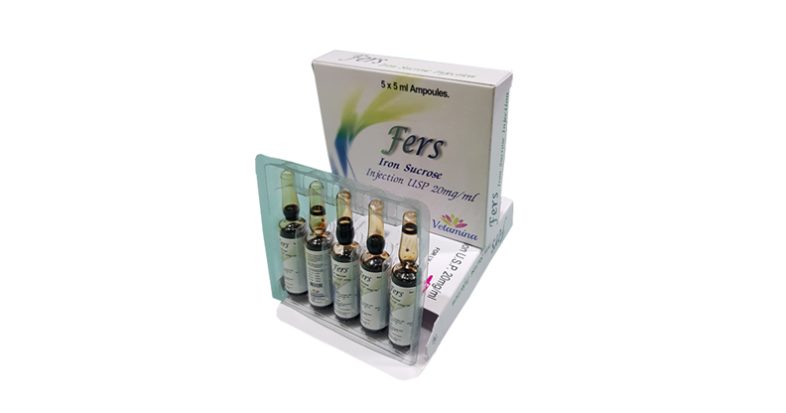FERS

IRON SUCROSE INJECTION U.S.P. 20 MG/ML
PRODUCT NAME
- FERSGeneric Name or INN Iron Sucrose Injection U.S.P. 20 mg/ml
- Name and Strength of the active Ingredient (s)
- Each ml contains
- Ferric Hydroxide in complex with
- Sucrose Equivalent to Elemental Iron 20mg
- Water for injections BP qs
PRODUCT DESCRIPTION
- Physical properties
- A Clear reddish Brown color liquid
PHARMACODYNAMICS / PHARMACOKINETICS
PHARMACOTHERAPEUTIC GROUP
- Pharmacotherapeutic group: Anti-anaemic preparation, iron, And parenteral preparation, ATC code: B03AC
MECHANISM OF ACTION
Iron sucrose, the active ingredient of FERS, is composed of a polynuclear iron (III)-hydroxide core surrounded bya large number of non-covalently bound sucrose molecules. The complex has a weight average molecular weight (Mw)Of approximately 43 kDa. The polynuclear iron core has a structure similar to that of the core of the physiological iron Storage protein ferritin. The complex is designed to provide, in a controlled manner, utilisable iron for the iron transport and storage proteins in the body (i.e., transferrin and ferritin, respectively).
Following intravenous administration, the polynuclear iron core from the complex is taken up predominantly by the reticuloendothelial system in the liver, spleen, and bone marrow. In a second step, the iron is used for the synthesis of Hb, myoglobin and other iron-containing enzymes, or stored primarily in the liver in the form of ferritin.
Following intravenous administration, the polynuclear iron core from the complex is taken up predominantly by the reticuloendothelial system in the liver, spleen, and bone marrow. In a second step, the iron is used for the synthesis of Hb, myoglobin and other iron-containing enzymes, or stored primarily in the liver in the form of ferritin.
PHARMACOKINETICS DISTRIBUTION
The ferrokinetics of iron sucrose labelled with 52Fe and 59Fe were assessed in 6 patients with anaemia and chronic Renal failure. In the first 6–8 hours, 52Fe was taken up by the liver, spleen and bone marrow. The radioactive uptake by the macrophage-rich spleen is considered to be representative of the reticuloendothelial iron uptake.
Following intravenous injection of a single 100 mg iron dose of iron sucrose in healthy volunteers, maximum total Serum iron concentrations were attained 10 minutes after injection and had an average concentration of 538 μmol/l. TheVolume of distribution of the central compartment corresponded well to the volume of plasma (approximately 3 litres).
Following intravenous injection of a single 100 mg iron dose of iron sucrose in healthy volunteers, maximum total Serum iron concentrations were attained 10 minutes after injection and had an average concentration of 538 μmol/l. TheVolume of distribution of the central compartment corresponded well to the volume of plasma (approximately 3 litres).
BIOTRANSFORMATION
Upon injection, sucrose largely dissociates and the polynuclear iron core is mainly taken up by the reticuloendothelial System of the liver, spleen, and bone marrow. At 4 weeks after administration, red cell iron utilization ranged from 59 to 97%.
ELIMINATION
The iron sucrose complex has a weight average molecular weight (Mw) of approximately 43 kDa, which is sufficiently Large to prevent renal elimination. Renal elimination of iron, occurring in the first 4 hours after injection of a FERS dose of 100 mg iron, corresponded to less than 5% of the dose. After 24 hours, the total serum iron Concentration was reduced to the pre-dose level. Renal elimination of sucrose was about 75% of the administered dose..
INDICATION
- FERS is indicated for the treatment of iron deficiency in the following indications:
- Where there is a clinical need for a rapid iron supply.
- In patients who cannot tolerate oral iron therapy or who are non-compliant.
- In active inflammatory bowel disease where oral iron preparations are ineffective.
- In chronic kidney disease when oral iron preparations are less effective.
RECOMMENDED DOSE
Monitor carefully patients for signs and symptoms of hypersensitivity reactions during and following each Administration of FERS.FERS should only be administered when staff trained to evaluate and manage anaphylactic reactions is Immediately available, in an environment where full resuscitation facilities can be assured. The patient should be Observed for adverse effects for at least 30 minutes following each FERS administration.
Posology The cumulative dose of FERS must be calculated for each patient individually and must not be exceeded.
Posology The cumulative dose of FERS must be calculated for each patient individually and must not be exceeded.
RECOMMENDED ROUTE OF ADMINISTRATION
- Intravenous
CONTRAINDICATIONS
- Known serious hypersensitivity to other parenteral iron products.
- Anaemia not caused by iron deficiency.
- Evidence of iron overload or hereditary disturbances in utilisation of iron.
WARNINGS AND PRECAUTIONS
Parenterally administered iron preparations can cause hypersensitivity reactions including serious and potentially fatal Anaphylactic/anaphylactoid reactions. Hypersensitivity reactions have also been reported after previously uneventful Doses of parenteral iron complexes including iron sucrose.
There is also an increased risk of hypersensitivity reactions to parenteral iron complexes in patients with immune or Inflammatory conditions (e.g. systemic lupus erythematous, rheumatoid arthritis).
FERS should only be administered when staff trained to evaluate and manage anaphylactic reactions is Immediately available, in an environment where full resuscitation facilities can be assured. Each patient should be Observed for adverse effects for at least 30 minutes following each FERS injection. If hypersensitivity reactions or Signs of intolerance occur during administration, the treatment must be stopped immediately. Facilities for cardio Respiratory resuscitation and equipment for handling acute anaphylactic/anaphylactoid reactions should be available, Including an injectable 1:1000 adrenaline solution. Additional treatment with antihistamines and/or corticosteroids Should be given as appropriate.
There is also an increased risk of hypersensitivity reactions to parenteral iron complexes in patients with immune or Inflammatory conditions (e.g. systemic lupus erythematous, rheumatoid arthritis).
FERS should only be administered when staff trained to evaluate and manage anaphylactic reactions is Immediately available, in an environment where full resuscitation facilities can be assured. Each patient should be Observed for adverse effects for at least 30 minutes following each FERS injection. If hypersensitivity reactions or Signs of intolerance occur during administration, the treatment must be stopped immediately. Facilities for cardio Respiratory resuscitation and equipment for handling acute anaphylactic/anaphylactoid reactions should be available, Including an injectable 1:1000 adrenaline solution. Additional treatment with antihistamines and/or corticosteroids Should be given as appropriate.
FERTILITY, PREGNANCY AND LACTATION
PREGNANCY
There is no data from the use of iron sucrose in pregnant women in the first trimester. Data (303 pregnancy outcomes) From the use of FERS in pregnant women in the second and third trimester showed no safety concerns for the Mother or newborn.
A careful risk/benefit evaluation is required before use during pregnancy and FERS should not be used during Pregnancy unless clearly necessary Iron deficiency anaemia occurring in the first trimester of pregnancy can in many cases be treated with oral iron. Treatment with FERS should be confined to second and third trimester if the benefit is judged to outweigh the Potential risk for both the mother and the foetus.
Animal studies do not indicate direct or indirect harmful effects with respect to reproductive toxicity.
A careful risk/benefit evaluation is required before use during pregnancy and FERS should not be used during Pregnancy unless clearly necessary Iron deficiency anaemia occurring in the first trimester of pregnancy can in many cases be treated with oral iron. Treatment with FERS should be confined to second and third trimester if the benefit is judged to outweigh the Potential risk for both the mother and the foetus.
Animal studies do not indicate direct or indirect harmful effects with respect to reproductive toxicity.
BREAST-FEEDING
There is limited information on the excretion of iron in human milk following administration of intravenous iron Sucrose. In one clinical study, 10 healthy breast-feeding mothers with iron deficiency received 100 mg iron in the form of iron sucrose. Four days after treatment, the iron content of the breast milk had not increased and there was no Difference from the control group (n=5). It cannot be excluded that newborns/infants may be exposed to iron derived From FERS via the mother’s milk, therefore the risk/benefit should be assessed.
Preclinical data do not indicate direct or indirect harmful effects to the nursing child. In lactating rats treated with 59Fe- Labelled iron sucrose, low secretion of iron into the milk and transfer of iron into the offspring was observed. Nonmetabolised iron sucrose is unlikely to pass into the mother’s milk.
Preclinical data do not indicate direct or indirect harmful effects to the nursing child. In lactating rats treated with 59Fe- Labelled iron sucrose, low secretion of iron into the milk and transfer of iron into the offspring was observed. Nonmetabolised iron sucrose is unlikely to pass into the mother’s milk.
FERTILITY
No effects of iron sucrose treatment were observed on fertility and mating performance in rats.
UNDESIRABLE EFFECTS
- Immune system disorders : Hypersensitivity, Anaphylactoid reactions, angioedema
- Nervous system disorders : Headache, dizziness, paraesthesia, hypoaesthesia
- Cardiac disorders : Palpitations, Bradycardia, tachycardia Vascular disorders, Hypotension, hypertension, Flushing, phlebitis, Circulatory collapse
- Thrombophlebitis Respiratory, thoracic and mediastinal disorders : Dyspnoea, Bronchospasm
- Skin and subcutaneous tissue disorders : Pruritus, rash, Urticaria, erythema
OVERDOSE AND TREATMENT
Overdose can cause iron overload which may manifest itself as haemosiderosis. Overdose should be treated, as Deemed necessary by the treating physician, with an iron chelating agent or according to standard medical practice.
DOSAGE FORMS AND PACKAGING AVAILABL
5 X 5 ML Ampoules

